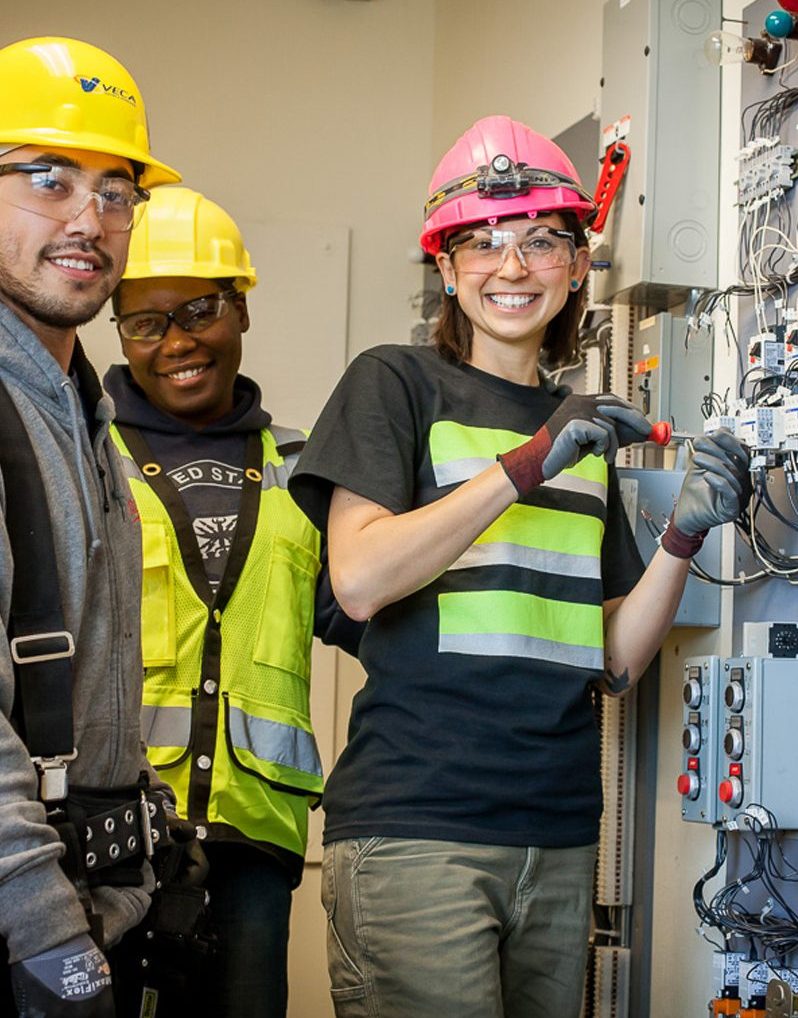
We offer a choice of two different electrical career paths, each focusing on a specific area of the electrical industry
The electrical industry is varied and exciting. Depending on your interests and goals for your electrical career path, we have a program that will fit your desires. Our apprentices work within the IBEW Local 354 jurisdiction which is the entire state of Utah.
Inside Wireman
The scope of work involves the electrical systems and foundations found in any commercial or industrial building. The program consists of 8,000 hours of on-the-job training and 1,000 hours of classroom education. When the Inside Wireman apprenticeship is completed and an apprentice passes the Utah State Electrical Journeyman test, they will hold a Journeyman Level Electrician certification from the State of Utah. Plans new or modified installations and repairs to existing systems in dwellings or commercial buildings. Studies blueprints, manufacturer’s directions, and contractor’s specifications to determine what is to be done, adequacy of existing wiring or planned installations, and materials, equipment and time needed to complete job; prepares drawings of electrical installations to facilitate work; consults architect or general contractor pertaining to questionable items, delays, or unusual problems. *Installs new and repairs existing electrical material and equipment in dwellings or commercial buildings: Measures, cuts, bends and shapes, threads, assembles and installs exposed, concealed and recessed electrical raceways, feeder and branch systems using such tools as hacksaw, pipe threaders, hickey, hand or power-drilling tools, pliers, and various bending devices. Levels panel boards and secures to floor with anchor bolts. Plumbs and braces switchboards. Installs conductor gutters and bolts them to wall or ceiling. Pulls and cuts wires. Pushes fishtape back to feed the conductor through the raceway. Uses mechanical power device to obtain required force for pulling large conductors. Splices wires by stripping terminal ends of insulation, twisting, soldering, or using connection devices. Identifies wires using standard equipment; tags ends or identified by color. Removes defective wiring and parts. Connects wiring to lighting fixtures, power equipment, convenience outlets, switches, and circuit breakers. Completes installations using hand tools such as pliers, wrenches, hammers, and screwdrivers. May operate hydraulic lifts to move and place heavy equipment and materials. May install reactors, capacitors, rectifiers and the wiring for electrically operated equipment such as hoists, elevators, and motors. *Test circuits: Tests continuity of circuits to ensure electrical reliability and safety of all components using standard electrical test and measuring instruments.
Telecommunication
While most installations are in buildings that are partially or fully enclosed to protect from sun, wind and rain; these installations are often installed before air conditioning, heat or permanent light fixtures have been installed in the buildings, many jobs, however, are existing buildings or offices; and some work may be outside under varying weather conditions. Backbone voice and data cables are routed between the entrance facility, where communication signals enter a building, to equipment rooms and telephone rooms. Voice and data horizontal cables are routed between telephone rooms or equipment rooms and individual workstations throughout the building. Equipment rooms often contain energized equipment such as hubs, file servers or telephone switches. These devices are configured and connected to the communications network that serves the building and must not be interrupted as a result of work performed by unqualified workers or those only partially trained. The Installer Technician installs voice and data outlets at workstations. In addition, they install punch down blocks and cross connects in telephone rooms. These may be wall mounted or rack mounted and must be grouped and identified according to specific installation standards. Whether the work is in new construction or in existing office or manufacturing space, the IBEW-NECA craftsman takes pride in the work that he or she has and can perform. The Electrical Training Alliance trains to TIA/EIA and other industry standards. The Electrical Training Alliance also partners with the major manufacturers in the video, voice and data industry to assure training in the latest technologies including training for manufactures warranted installs.
